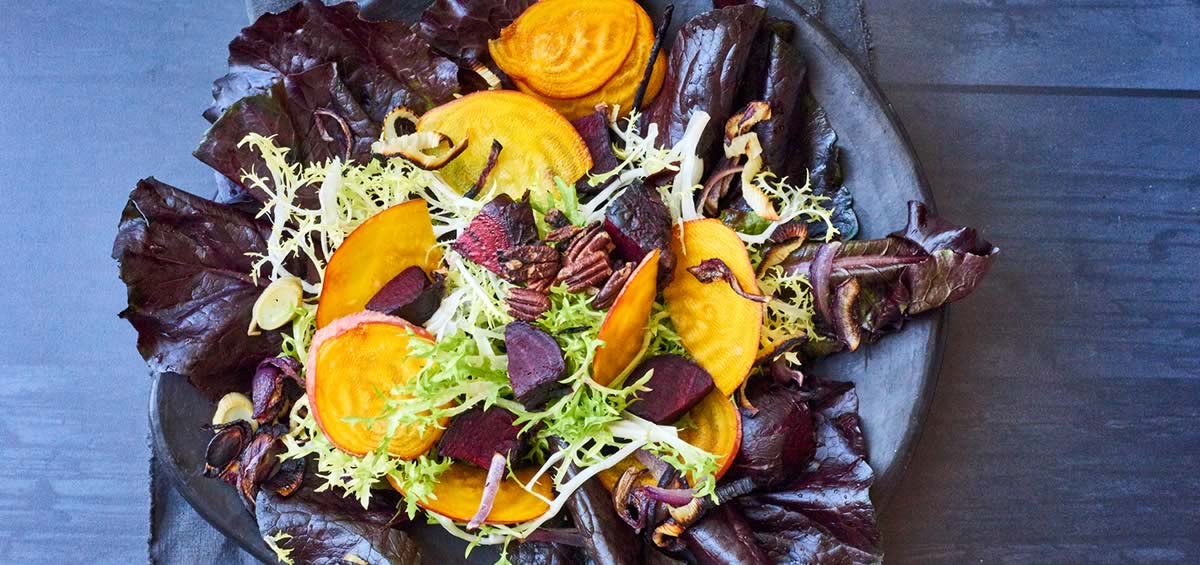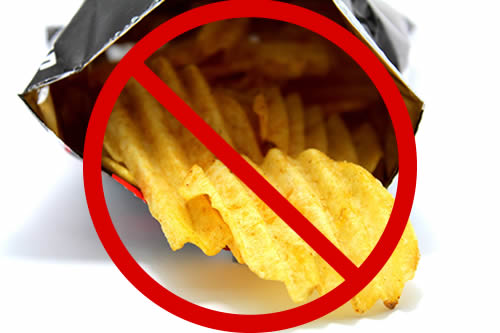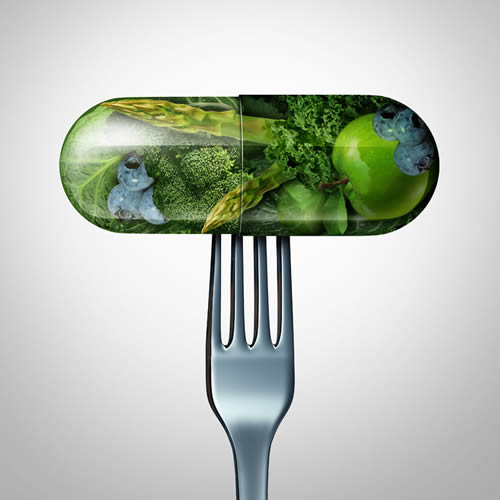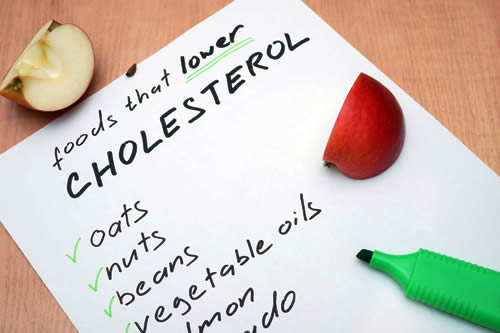
Serves 4 | Serving Size: 2 cups
Total Time: 50 min | Prep: 5 min | Cook: 45 min
A memorable delight for holidays and winter
Ingredients:
- 3 small red beets, roasted and cut in quarters
- 1 head of fennel, sliced thin
- 1/4 red onion, peeled and sliced thin
- vegetable oil cooking spray (or olive oil cooking spray)
- 4 cups assorted fresh lettuces (we used red romaine and frise)
- 1 golden beet, raw, sliced thin
- 2 tablespoons baked pecan halves
- Dressing: juice of one lemon, 2 tsp olive oil
Directions:
Roast the red beet in the oven at 400 for one hour. Allow to cool slightly then use a paper towel to slip off the skin. Cut in quarters.
Place the sliced red onion and fennel on a pan and spray with vegetable oil. Roast together until they are brown and crisp, about 40 minutes to one hour.
Toast the pecans for 4 minutes.
Arrange the lettuce on a platter with the darkest one on the outside. Add shaved golden beets, quartered roasted red beets, toasted pecans, and carmelized onion and fennel. Mix the lemon and olive oil and drizzle over the top. Serve immediately.
Chef’s Tips:
You can make all of the ingredients ahead of time and then assemble at the last minute. If you don’t have golden beets you can use carrots.
| Nutrition Facts | |
|---|---|
| Serving Size 2 cups Servings Per Batch 4 |
|
| Amount Per Serving | |
| Calories 144 | Calories from Fat 48 |
| % Daily Value * | |
| Total Fat 5g | 8% |
| Saturated Fat 1g | 3% |
| Trans Fat 0g | |
| Cholesterol 0mg | 0 |
| Sodium 124mg | 5% |
| Total Carbohydrate 23g | 7% |
| Dietary Fiber 9g | 35% |
| Sugars 10g | |
| Protein 5g | 9% |
| Vitamin A 274% | • Vitamin C 41% |
| Calcium 10% | • Iron 16% |
| * Percent Daily Values are based on a 2,000 calorie diet. Your daily values may be higher or lower depending on your calorie needs. | |
© Food and Health Communications
Woodholme encourages a healthy diet and proper nutrition as one aspect of maintaining heart health. The nutrition information and recipes are presented for informational purposes only and are not intended to take the place of one-on-one advice from your doctor. Please follow your personal physician’s recommendations if any recipes, ingredients, or advice found here conflict with what your doctor

 The purpose of this AHA presidential advisory on dietary fats and CVD is to review and discuss the scientific evidence, including the most recent studies, on the effects of saturated fat and replacing saturated fat with other types of fat or carbohydrate.
The purpose of this AHA presidential advisory on dietary fats and CVD is to review and discuss the scientific evidence, including the most recent studies, on the effects of saturated fat and replacing saturated fat with other types of fat or carbohydrate. A recent study from the University of Alabama at Birmingham supports findings from other studies showing that vitamin supplements do not lower the risk of heart disease. Among the supplements examined neither calcium or vitamin D, both of which are often recommended by physicians, have any clinical impact.
A recent study from the University of Alabama at Birmingham supports findings from other studies showing that vitamin supplements do not lower the risk of heart disease. Among the supplements examined neither calcium or vitamin D, both of which are often recommended by physicians, have any clinical impact. Consume foods that are naturally high in fiber, especially soluble fiber. Soluble fiber is found in legumes, fruits and root vegetables, as well as oats, barley and flax. For every 1 or 2 grams of soluble fiber you consume daily, you will lower your LDL by 1%. Try to consume 10-25 grams of soluble fiber per day. Psyllium husk may help those who have trouble consuming enough; talk to your physician if this is the case.
Consume foods that are naturally high in fiber, especially soluble fiber. Soluble fiber is found in legumes, fruits and root vegetables, as well as oats, barley and flax. For every 1 or 2 grams of soluble fiber you consume daily, you will lower your LDL by 1%. Try to consume 10-25 grams of soluble fiber per day. Psyllium husk may help those who have trouble consuming enough; talk to your physician if this is the case.